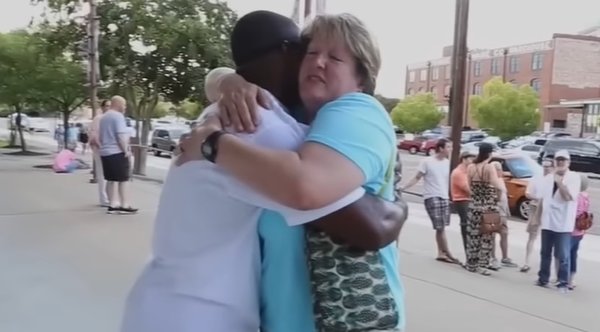Prelude to courage
March 5, 2012
It’s the 1980s, and I am sitting in the Beverly Hills living room of a major 1950s television star, alongside my romantic and sometimes writing partner. I have obtained a magazine assignment for us to write about this international celebrity, secured an interview with the retired grande dame herself, done the bulk of the research, created a list of questions, and organized them to ensure a smooth conversational flow. But when the moment comes to push “start” on the tape recorder, my partner launches into the interview, while I clam up and my brain goes blank. I make myself invisible; he runs the whole show.
Later, I transcribe the interview as well as several others, do more than half of the writing and virtually all of the rewriting, and turn the story in to our editor. My partner brings up the question of the order in which our names will appear on the piece. I know I deserve the first byline, but he’s not offering, and as a lifelong good Catholic girl, it is impossible for me to claim my due. Besides, I don’t want to piss him off; he has a temper that frightens me.
My insides feel simultaneously numb and sick, like there’s a knife I am twisting through my own intestines. Not looking him in the eye, I say he should have the first byline. Incapable of expressing my anger, I end up punishing myself.
Historically, many societies have viewed anger as “bad”—an emotion that must be suppressed or concealed, lest it do terrible damage when it’s unleashed. But it’s natural to feel anger in the course of our daily lives, whether it’s triggered by trivial annoyances (another driver cuts you off at the intersection) or by serious issues (you’re passed over for a well-earned promotion because of nepotism). What to do with all that anger before it boils over?
Fortuntately, recent research in the behavioral and biological sciences suggests that, when recognized and channeled, anger can improve health, enhance intimacy, further social justice and spur creativity. “Anger is the emotional energy within each of us that rises when something needs to change,” says therapist and author Tina Tessina. “If you act on the need to create change, your anger can be channeled effectively. But if it’s not redirected to something effective, your frustration will build, sometimes to hurricane force.”
Anger can indeed feel like a hurricane—and, if unregulated, can be just as destructive to physical and mental health. According to a 2010 University of Valencia study, this universal human emotion raises heart rate and arterial tension, which can stress the body, and increases testosterone production, preparing us for aggression.
Clinical psychologist Leon Seltzer notes, “Anger is the one emotion that mobilizes every organ and muscle group.” The body responds to what it perceives as a threat, activating our primal fight-or-flight response. Repeated stimulation of fight-or-flight can weaken the immune system and exhaust the body. High levels of anger have been found to destroy T-cells, a type of white blood cell that helps protect us from cancer and other diseases. Studies have also linked unregulated anger to headaches, colds and flu, as well as to increased risks of stroke, hypertension, gastrointestinal illnesses, and coronary artery disease.
The psychological effects of prolonged or uncontrolled anger are just as harmful. Anger has been associated with increased risk taking, poor decision making and substance misuse, as well as with such mental health problems as depression and self-harm. Many people cite anger as the emotion most likely to have a negative effect on personal relationships.
In my case, the mere idea of anger was so terrifying that I would spend a lifetime numbing myself to its effects. It didn’t help that I was raised in the Catholic Church, which from early Christian times has defined anger as one of the Seven Deadly Sins (punishable by an eternity in Hell). I am also from a Puerto Rican family, in which women typically learn to be submissive to men. But when I stuffed my anger, it didn’t go away. In fact, as I later learned, I was in the thrall of what psychologists call passive anger, meaning that the anger came out in other ways—such as self-sacrifice, self-sabotage and self-blame.
When anger arises, it’s easy to feel cornered, powerless, even scared. How to deal with your best friend who’s been neglecting you since she fell in love? What to do with your impossibly hormonal teenager when he’s acting out for the umpteenth time? We don’t do ourselves any favors when we don’t deal with our anger. Many studies have shown the damaging effects that unexpressed anger can have. Most recently, a study by Stockholm’s Stress Research Institute found that heart attack risks doubled in men who did not express their anger when they felt they had been unfairly treated in their jobs.
Scientists from both the behavioral and biological fields agree that anger is a normal human response. The issue is what to do with it. If uncontrolled anger can destroy our T-cells and unexpressed anger might lead to heart attacks, where’s the healthy middle ground?
A few months after the interview incident, I’m in the ladies’ room at the library and catch a glimpse of a severely depressed woman. Suddenly, I realize it’s me in the mirror. Shocked at my visible sadness, I go home and tell my partner we need to get into couples counseling. He refuses to “air our dirty laundry,” but I am so unhappy I know I must go to a therapist, even without him.
At my first session, after I’ve wept for an hour, my new therapist startles me with this pronouncement: “Depression is anger turned inward.” Later, a recently divorced girlfriend shares with me a quote by Eric Hoffer: “Anger is the prelude to courage.” I write this down in my journal and look at it, frequently. It strengthens something inside me, bit by bit.
Part of the problem for me was that in my mind, anger was only hurricane force. I had no concept that there might be some other form of anger, something healthier, even useful. Let’s say you’re at a party and you overhear someone make a racial slur that just happens to apply to you. Or what if the nursing home staff repeatedly ignores your instructions about your elderly mother’s special dietary needs? How to address these situations in a way that’s not explosive but effective?
My own fearfulness about anger didn’t just come from Catholicism. In many of the world’s spiritual traditions, anger is something to be avoided or quelled. The Qu’ran has many proscriptions against anger, and the Prophet Muhammad said, “The strongest man is the one who, when he gets angry and his face reddens and his hackles rise, is able to defeat his anger.” The Jewish Kabbalah has meditations for healing the soul of anger. In Buddhism, anger is one of the Five Hindrances, negative mental states that interfere with enlightenment.
But men’s movement pioneer John Lee argues that when people talk about anger, what they often mean is rage—and that anger and rage are two distinct phenomena. “Healthy anger is an emotion that everybody on the planet is going to have and has a right to have,” says the psychotherapist and author of Facing the Fire: Experiencing and Expressing Anger Appropriately and The Anger Solution. “Unhealthy anger, or rage, is an action or behavior that nobody has the right to commit against somebody else. Basically, anger is a feeling. Rage is an action or a behavior that numbs people’s feelings.”
But let’s say you’re in a relationship, and the hurricane force rises in you. How do you know if it’s healthy anger or destructive rage? “With healthy anger, it’s always about what’s happening now,” says Lee. You might be upset at something your wife said when you were getting ready for work that morning. You express it, you and she discuss it and it’s resolved.
Rage, on the other hand, is an accumulation of feelings about the past. It’s when you’re furious because of what she’s been saying to you every morning for the past two years, and you’ve been making up conversations in your head about it, and furthermore, every time she does it, it triggers decades of stuffed feelings about how your mother mistreated you when you were a child. This is how the hurricane force looks when it’s ready to wreak havoc.
Biochemically, when you are in a state of rage, you’ve moved from your prefrontal lobe “down to your midbrain, where you can only fight, be in flight or freeze,” says Lee. That’s why rage is uncontrollable—and frightening. But with healthy anger, you’re still in your prefrontal lobe, where capable of managing your responses.
Lee believes healthy anger can bring people closer. “Healthy anger draws people into a conversation,” he explains. “If I express anger appropriately, you’re going to stay open and listen and in the process you’re going to get to know me better.” Many of us have had the classic experience of a lover’s quarrel in which we aired our hurts and allowed ourselves to open vulnerably to our partners. The result can indeed be more intimacy.
Harriet Lerner, psychotherapist and author of the classic, The Dance of Anger: A Woman’s Guide to Changing the Patterns of Intimate Relationships, takes this notion further. “Healthy anger requires us to define ourselves and to be the best expert on what values, priorities and desires are not negotiable under relationship pressures,” she says. “It requires us to change our part in the relationship patterns from which our anger springs.”
Lerner sees healthy anger as a powerful tool for increasing respect and fulfillment in relationships with loved ones. “Healthy anger requires self-focus, so we can observe and change our part in the patterns that keep us stuck, rather than dissipating our energy trying to change another person who doesn’t want to change.”
No question about it: using anger to improve personal relationships can be a challenge. But what about those guys in the Stockholm study, the ones who suppressed their anger in the workplace and thereby doubled their risk of heart attack? Is there an appropriate way to funnel anger on the job? Professional mediator Vivian Scott, author of Conflict Resolution at Work for Dummies, actually sees workplace anger as “an opportunity to make something better. The company has the opportunity to benefit if people can take on the attitude that the conflict can be a symptom of something that can be improved—a process, a system or an overall attitude.”
And what would healthy anger look like in the workplace? Whether one’s angry at a boss or at an employee, the expression of anger at work is tricky, with both perceived and real risks. It’s important, says Scott, to “remember that the other person is not against you—she’s just for herself. Take a second and logically put yourself in her shoes. Ask rather than assume. Say something like, ‘I noticed we’ve been having some challenges lately and I’m wondering if you can help me understand what’s happening so we could work together to find a solution that would work for both of us.’ It works at all levels.”
Scott’s advice is timely. A public poll carried out for a 2008 British Mental Health Foundation report titled “Boiling Point: Problem Anger and What We Can Do About It” showed that “a majority of the [British] population believe that people in general are getting angrier.” More recently, in August of last year, CNN released a poll in which 70 percent of Americans described themselves as angry. That’s easy to believe when you see the footage of furious tea party throngs gathered for the “Restoring Honor” rally put on by the wildly popular right-wing TV commentator Glenn Beck on the Washington Mall around the same time.
Let’s face it: We have plenty to be angry about, from the ongoing economic crisis to massive job uncertainty to widespread political gridlock. And as people feel increasingly powerless over their circumstances, their anger levels go up. A 2009 study by University of Toronto sociology professor Scott Schieman found that individuals with less education, younger adults, financially strained people and parents with children in the house tend to experience higher levels of anger.
What should we do with all that fury? The truth is, many social and political justice movements have been fueled by the anger of the oppressed: women’s suffrage, the American civil-rights movement, Czechoslovakia’s Velvet Revolution, Tiananmen Square. The contemporary poet Joy Harjo, who is of Cherokee and Creek descent, has pointed out, “Native American experience has often been bitter. … I like to think that bitter experience can be used to move the world.” In her poem “For Anna Me Pictou Aquash,” about the U.S. cavalry’s murder of Lakota Sioux during the 1890 Wounded Knee Massacre, she puts forth this beautiful image: “We have just begun to touch / the dazzling whirlwind of our anger.”
Personal anger at injustice was what impelled Mahatma Gandhi to lead India to liberation. As a young attorney, he was traveling on a train in South Africa. A European passenger complained about this non-white “coolie” being allowed into the first-class coach, even though Gandhi had a first-class ticket. Gandhi was thrown out of the compartment. After much soul searching, he decided to dedicate himself to changing the social conditions that had given rise to the incident. Gandhi’s steady channeling of raw anger into effective, nonviolent action was the dazzling whirlwind that eventually enabled the Indian people to end British colonial rule.
Sure, you might think, Gandhi led an entire subcontinent to liberation, but what can I do with all my social outrage? If we think of our anger as a signpost showing us where changes are needed, it’s possible to come up with positive actions, especially at the local level. In the small New Mexico town where I live, one of my friends was so angry about the BP oil spill in the Gulf of Mexico that she created a community ride-share board on Facebook to lessen our dependence on oil. Another friend, concerned about rampant unemployment, is organizing a time bank so people can exchange skills rather than money. Turning your sociopolitical anger into positive action restores your sense of power—and contributes to the well-being of the planet.
After a year of therapy, I finally gathered up the courage to leave my partner. I celebrated the start of my new life by treating myself to a double bill of Fred Astaire and Ginger Rogers films at a classic movie theater. I was ecstatic watching the exquisitely equal, graceful partnership of my favorite on-screen dancers. I continued to see my therapist for another five years, gradually dismantling old relationship patterns and building healthy new ones—patterns that embrace and honor all my feelings, including the long-forbidden anger.
As I accustomed myself to feeling anger as it happens naturally and explore ways to channel it productively, I discovered that some people use anger to fuel their creativity. Rock musician and actor Anand Bhatt, the son of Hindu Indian parents, grew up in a predominantly white, Christian suburb outside Chicago, where he experienced intense racial abuse as a child. Other kids and their parents told him he was going to Hell because he was neither white nor Christian. His house was repeatedly egged. Nazi symbols were painted on the driveway. kids stole his clothes and shoes during gym class and urinated on them. No adults in authority ever intervened.
By his twenties, Bhatt was numbing his rage by drinking heavily. Eventually he stopped drinking, dealt with his emotions and, he says, “Through a regular process of meditation, I began to realize that much of any character I had developed was from this social hardship. My rage transferred to a very productive passion to succeed and claim my right to be an important member of my own society.”
Now, whenever he experiences racism, he uses it to ignite his artistic impulses. For example, he recently heard that a Utah newscaster had talked about him on the air, commenting that “being not-white was a ‘social disorder’ that I had to deal with.” Bhatt channeled his anger into writing and recording a new song with Dallas Coyle, the former guitar player for the heavy metal band God Forbid. So fired up were they, Bhatt says, “We cranked out those vocals parts in one take!”
According to a study led by University of Amsterdam psychologist Gerben van Kleef, that’s not the only way creativity might be sparked by anger. In the study, some subjects were exposed to directions for creative tasks given by an angry man; others received directions from an emotionally neutral man. The researchers found that exposure to the angry man increased the creativity of some of the subjects as well as boosting their originality. Expressions of anger do not just lead individuals to generate more ideas but also to generate more original ideas, Van Kleef concluded.
The anger-creativity connection has not gone unnoticed outside the laboratory. Anger is “creative energy that is not being rightly used,” said the Indian guru Osho in the 1970s. Psychologist Stephen Diamond also sees anger as a form of creativity. In his book Anger, Madness, and the Daimonic: The Psychological Genesis of Violence, Evil, and Creativity, Diamond looked at the creative processes of such artists as Picasso and Beethoven, Richard Wright and Jackson Pollock, and discovered expressive impulses fed by anger. “During this alchemical activity,” he says, “we come to discover the surprising paradox that many artists perceive: that which we had previously run from and rejected turns out to be the redemptive source of vitality, creativity and authentic spirituality.”
So we can learn to distinguish between healthy anger and unhealthy rage, de-numb ourselves if necessary and channel our healthy anger into productive changes. Is there a next stage after that? Bhatt, the musician and actor, says that as he faced his anger in his meditations, “I began to realize that others weren’t to blame. I was responsible for my own reactions and emotions.” Might it be possible, then, not only to accept responsibility for one’s feelings but develop real compassion for one’s wounds?
This is precisely how the Buddhist monk and peace activist Thich Nhat Hanh advises us to deal with our anger: with the deepest of tenderness and care. “Anger is like a howling baby, suffering and crying,” he writes in Anger: Wisdom for Cooling the Flames. “When the mother embraces her baby, her energy penetrates him and soothes him. This is exactly what you have to learn to do when anger begins to surface.” Nhat Hanh explains that the mother holds the baby not only to comfort him but to divine the source of his pain. That, too, is our job when we experience anger: to hold ourselves and know where we’re hurt.
The Dalai Lama takes this idea even further. In Healing Anger: The Power of Patience from a Buddhist Perspective, he addresses the often-asked question of how he and his fellow Tibetan Buddhist monks have dealt with the Chinese occupation of their homeland. “Even if there is a likelihood of some feeling of anger arising, we deliberately check ourselves and try to reduce that, and try to deliberately develop a feeling of compassion toward the Chinese.” And so, in the face of the understanding that one’s oppressors are suffering human souls who deserve compassion, all anger disappears.
Fifteen years had passed since I had last seen my ex when I was hired to be a producer-writer for a TV show I love—at a network where my ex also happened to work. On my first day on the job, knowing I would run into him sooner or later, I decided to avert discomfort and send him a friendly email. He responded by inviting me out for coffee.
At our get-together, he surprised me with a videotape he had made: a compilation of the best moments of Ginger Rogers dancing. “You taught me to see her as well as Fred Astaire,” he offered. I understood that he was saying much more. I felt the weight that this ordinary videotape carried: the weight of apology, of appreciation, of acknowledgment, of respect. Deeply moved, I gratefully accepted his gift. If I had been holding any shred of my old anger toward him, it dissolved in that instant.
Source: Ode Wire
Click Here For The Most Popular On Sunny Skyz
 Boy With Down Syndrome Nails The Whitney Houston Challenge, And The Crowd Goes Wild
Boy With Down Syndrome Nails The Whitney Houston Challenge, And The Crowd Goes Wild
 Husband Rents Mall Store To Share His Late Wife's Beloved Christmas Display
Husband Rents Mall Store To Share His Late Wife's Beloved Christmas Display
 The ŌĆśGrandma StandŌĆÖ Is Bringing Comfort And Connection, One Conversation At A Time
The ŌĆśGrandma StandŌĆÖ Is Bringing Comfort And Connection, One Conversation At A Time
 The Funniest Wildlife Photos Of 2025 Are Here ŌĆö And TheyŌĆÖre Hilarious
The Funniest Wildlife Photos Of 2025 Are Here ŌĆö And TheyŌĆÖre Hilarious
 This Priest Secretly Became A Masked Wrestler To Fund An Orphanage
This Priest Secretly Became A Masked Wrestler To Fund An Orphanage
 This 30-Year-OldŌĆÖs Christmas Gift To His Mom Is Going Viral
This 30-Year-OldŌĆÖs Christmas Gift To His Mom Is Going Viral
 Dad Jokes With Tom Hardy And His Dad
Dad Jokes With Tom Hardy And His Dad
 After 2 Years Apart, Siblings In Foster Care Are Finally Reunited
After 2 Years Apart, Siblings In Foster Care Are Finally Reunited
 The Hug That Went Viral On Facebook
The Hug That Went Viral On Facebook
 You Have To See This 'Piggy Train' Trotting Through The Snow
You Have To See This 'Piggy Train' Trotting Through The Snow
 He Asked For Help Wrapping A Christmas Present ŌĆö Then Surprised Her With A Life-Changing Gift
He Asked For Help Wrapping A Christmas Present ŌĆö Then Surprised Her With A Life-Changing Gift

